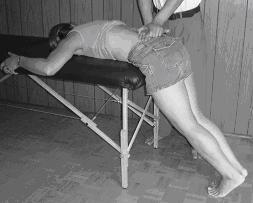Prone Instability Test for the Lumbar Spine
Step 1: The patient lays only half way up the bed, with the hips flexed, the trunk muscles relaxed and the feet resting on the floor. A PA pressure is applied over the most symptomatic spinous process.
Step 2: The PA pressure is let go and the patient is requested to slightly lift the feet off the floor. The patient requires holding on to the sides of the bed for support as this will produce a co-contraction of the global abdominal, gluteal and erector spinae muscles.
Step 3: The PA pressure is re-applied over the same level spinous process. If a dramatic reduction or the complete elimination of the symptoms is noted compared to step 1, it is considered a positive prone instability test.
Posted on: November 10, 2005
Categories: Lumbar Spine


